 In NASCAR, pit crew members use impact wrenches with preset torque values to install lug nuts during a wheel change. A loose lug nut can mean the difference between winning and losing, as Greg Biffle found out in 2005 when loose lug nuts on the left rear tire caused vibration and forced him to take an extra pit stop at the Texas Motor Speedway. Biffle lost a lap and finished 20th, which cost him enough points to lose the Chase for the Nextel Cup to Tony Stewart.
In NASCAR, pit crew members use impact wrenches with preset torque values to install lug nuts during a wheel change. A loose lug nut can mean the difference between winning and losing, as Greg Biffle found out in 2005 when loose lug nuts on the left rear tire caused vibration and forced him to take an extra pit stop at the Texas Motor Speedway. Biffle lost a lap and finished 20th, which cost him enough points to lose the Chase for the Nextel Cup to Tony Stewart.
No race car driver or their pit crew would question the importance of using the proper tool and the proper torque on lug nuts. Yet many electricians go to work every day and tighten electrical connections with no more than a folding Allen set.
Every electrician has a responsibility to understand how to install conductors and make connections according to manufacturer instructions. Equipment, including conductors and connectors, is manufactured, tested and listed to be installed as specified by the manufacturer. When a manufacturer designs a connector, it is designed to work with prescribed conductor(s) and a specific installation method, whether it is a set-screw or compression connector.
Set-screw connectors (photo 1) are very common in electrical equipment, including panelboards, switchboards, and meter bases. For field installation, the connector manufacturer usually publishes a set of installation instructions on the packaging. For terminations in equipment, the equipment manufacturer labels the equipment with the recommended installation torque and any other special instructions. If for some reason the recommended torque is not available on the connector or equipment, there are published tables of “default” torque values included in National Electrical Contractors Association (NECA) and Underwriters Laboratories (UL) standards and online in manufacturer catalogs. (“Default torque values” are not meant to override manufacturer’s recommended torque values; rather, they are to be used in the absence of manufacturer’s recommended values.) NEC Code-making Panel 1 has recently accepted a proposal to include torque tables in an Annex in the 2011 NEC
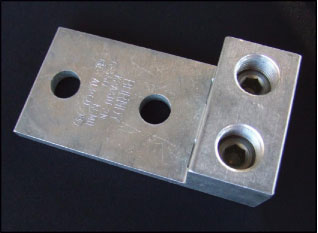
Photo 1. Mechanical set-screw used in torque test
It is common practice for most electricians to tighten mechanical set-screw connections without a torque wrench. Many good installers believe that they know how much to tighten set-screw connections without using a torque wrench because everything works when energized. What they rarely see is what happens a year or a decade down the road when the connection that was not properly installed begins to overheat and fail. Then the service electrician comes in, repairs the problem and tightens the new connector —without a torque wrench. These electricians aren’t intentionally doing inferior work; they simply do not understand how important correct torque is to the safety and long-term integrity of the electrical system. It has been estimated that 90% of electrical failures occur at connections. [1] How many of those connections would never have failed if properly tightened in the first place?
To determine how accurately installers tighten set-screw connectors without a torque wrench, a test assembly was designed using aluminum bar stock and BURNDY® K2A31U-2N lugs (photo 2). These lugs have a recommended tightening torque of 275 lb-in, or 22.9 lb-ft. Participants were given a choice of tools, either a 12-inch ratchet drive or a folding Allen set. The tightening torque applied was measured with a transducer and read from a remote digital meter, so only the test administrator could see the peak torque applied (photo 3).

Photo 2. Torque test assembly setup
Results from testing at four different electrical industry events were collected in 2009: The NJATC National Training Institute (NTI) Show in Ann Arbor, The NECA show in Seattle, an IAEI Chapter meeting in Las Vegas and the IAEI Southwestern Section meeting in Honolulu. Data was also collected from Mojave Electric service electricians in Las Vegas, Nevada. In all, there were 402 participants.
Many of the participants predicted they would over tighten the connections, but very few did. Table 1 summarizes the results of the overall study. The breakdown assumes that set-screw connections tightened to within +/- 20% are adequate, based on a study performed by the Georgia Power Research Institute (now known as NEETRAC. [2]
Not all of the test participants were electricians. To find out if electricians did any better making connections, participants at three of the events were asked if they were employed or trained as an electrician. Of the 208 participants who answered the question, 172 indicated yes. The results of the subset of participants who were employed or trained as an electrician are also shown in Table 1.
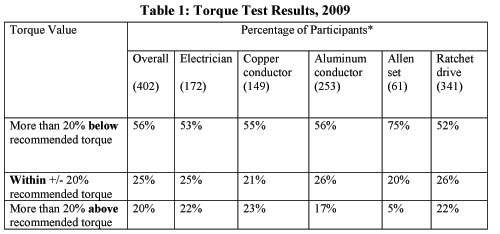
Table 1. Torque Test Results, 2009
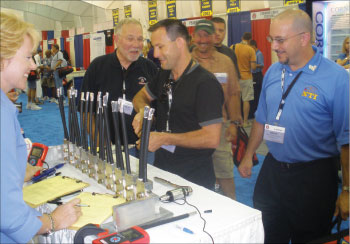
Photo 3. Participant at NTI tradeshow in Ann Arbor, Michigan
While the electricians were slightly more likely to over tighten connections than the entire group of participants, it is clear that they are no better at achieving a proper connection than someone with no experience as an electrician. Anecdotally, it was obvious during the test that people who had never made an electrical connection before had as much chance of getting it within 20% as an electrician with decades of experience. This indicates that achieving recommended torque is nearly independent of training and experience, and requires the use of a torque wrench to properly tighten a connection.
The connectors used for the test are listed for use with copper and aluminum conductors. To determine if the conductor used would make any difference, the test was performed with electrically equivalent 2/0 AWG copper and 4/0 AWG STABILOY® aluminum alloy building wire. These conductor sizes would typically be used for a 200-amp residential service according to the 2008 NEC Table 310.15(B)(6). The results using each conductor material are shown in Table 1. It appears that the tendency to under tighten the connection for both materials is virtually the same, and it is slightly more likely that copper conductors will be over tightened.
Over tightening a set-screw connection does not increase its reliability. It can, however, damage the lug or the equipment to which it is attached. It can even break conductor strands. Under tightening connections can lead to overheating and failure at the connection.

Photo 4. Torque screwdriver
Very few of the participants chose to use an Allen set instead of the ratchet, and Table 1 shows that those using the Allen set overwhelmingly under tightened the connections. Considering the prevalence of electricians using Allen sets in the field, the findings are disturbing, and may explain many of the connection failures we see in the field that occur within a few years after an installation is energized.
While this testing was performed on 2/0 AWG copper or 4/0 AWG aluminum conductors, smaller connections (such as those found on receptacles) also have a recommended installation torque. For example, UL Standards 20 and 1567 covering snap switches and receptacles call for binding wire screws to be tightened to 12 in.-lbs. Torque screwdrivers are available (photo 4), but very few electricians use them. Electricians indicated that they were more likely to use a torque wrench on larger conductors, such as those found on transformers or switchboards, but not on branch circuit connections. Only 36 of the 402 participants indicated that they always use a torque wrench or screwdriver to make electrical connections, while 247 answered that they sometimes use a torque wrench or screwdriver to make electrical connections (photo 5).
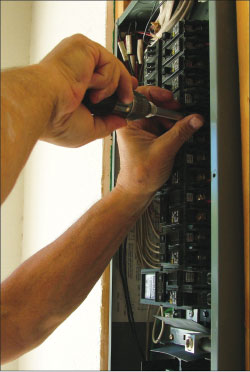
Photo 5. Electrician using torque screwdriver
So why don’t we have more failed connections if most electricians appear to be doing such a poor job tightening them? The fact is that our electrical system has built-in safety factors, and circuits are rarely fully loaded. Lightly loaded circuits put less stress on weak connections, so they may perform satisfactorily for many years before experiencing a problem, if ever. This is no justification to ignore basic installation instructions. Bottom line, a torque wrench is an easy and inexpensive way to improve the reliability and safety of an electrical system.
References
1. McPartland, J.F., “All electrical terminals must be torqued!” EC&M (1983).
2. Ganatra, R. and T. McKoon, “Reliability of connections: a comparison of aluminum alloy stranded conductors and electrically equivalent copper conductors.” Wire Journal International (1998).
3. Di Troia, G., K. Woo, and G. Zahlman, “Connector Theory and Application: A Guide to Connection Design and Specification.” FCI Electrical (1998).
Special thanks is given to Pete Pollak, P.E., for the idea that sparked this research, Randy Hunter for designing and building the test assembly, BURNDY® for contributing the lugs and assisting with data collection, and Alcan Cable for allowing the author to spend time and resources collecting the data and completing this article.
Christel Hunter, senior engineer, Alcan Cable. Chris holds bachelor of science degrees in engineering physics and electrical engineering and a masters in business administration. She has worked in the electrical industry for sixteen years including positions with the utility, regulatory and manufacturing sectors of the industry. Chris serves on NEC CMP-6 and CMP-7, CEC Section 4, chair of CANENA THSC20, and many other industry committees. She is an associate certified standards engineer, master electrician and LEED accredited professional.
Connector Testing
In the U.S., electrical connectors are tested according to standards published by Underwriters Laboratories. The connectors used in this test assembly were listed to UL Standard 486A-B. When tested according to this standard, the recommended installation torque must be applied. The standard also states that the test conductor shall not be wire-brushed, and oxide inhibitor can only be used if it is pre-filled in the connector. This is only true for the certification testing, and is intended to ensure accurate and repeatable results across a wide range of connectors. For field installations, the connector or equipment manufacturer will usually provide installation instructions on the packaging or an equipment label, including recommended torque and any requirement for wire brushing or oxide inhibitor application. NEC-2008 requires in 110.3(B) that “Listed or labeled equipment shall be installed and used in accordance with any instructions included in the listing or labeling.”
Connector Theory
For an electrical connection to achieve its objective of providing a low resistance, conductive path between two conductive elements, tightening the connector must create as many points of contact with the conductor as possible during initial installation. Every set-screw termination has an optimum value of tightening torque that produces the most reliable, low resistance joint. Torque (a force applied to a lever arm multiplied by the distance measured from the pivot point) on the set-screw creates pressure between the connector and the conductor. If too little torque is applied, the connection may not have sufficient pressure to create enough contact points to maintain a low resistance, conductive path over the life of the installation.
Contrary to common belief, set-screw connections do not require periodic retightening, whether installed on aluminum or copper wire. Once the connector is installed with the proper torque, repeated tightening could actually damage the connector and/or conductor and eventually lead to failure. Better practice is to make the initial connection with the recommended torque value, then periodically check for signs of loose connections or overheating (using visual inspections and thermal imaging) before making any adjustments. [3]













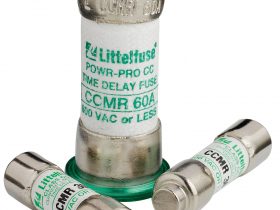
Find Us on Socials